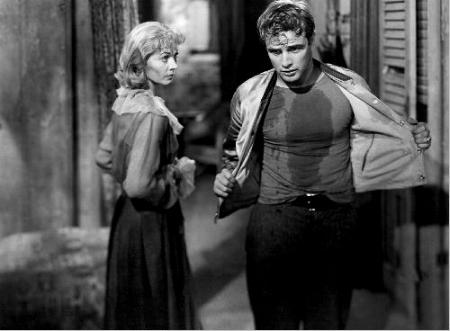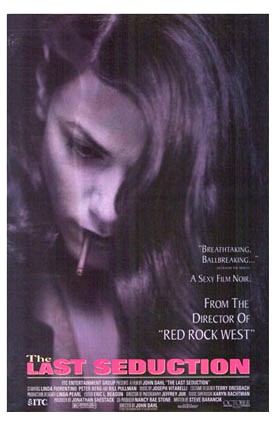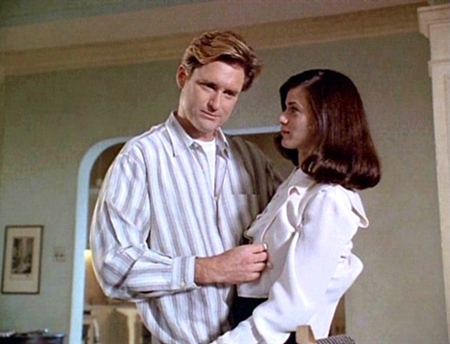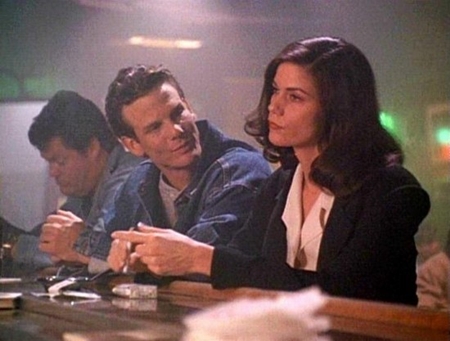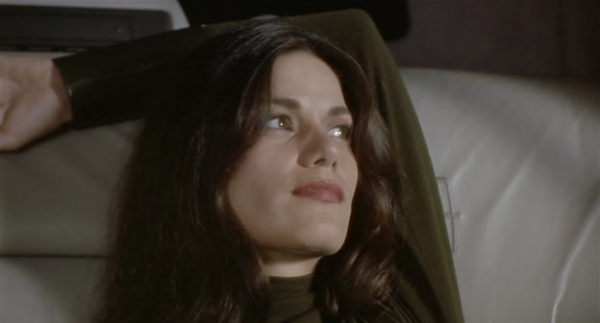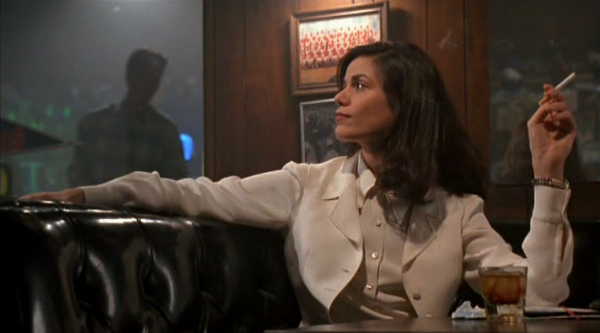Love Isn’t Always Soft and Gentle: Female Sexual Desire in Secretary by Jenny Lapekas
Sex and sexuality are complicated, whether we believe it or not. Most of us have experienced some type of same-sex attraction or participated in some kinky activity in the bedroom. Movies often help us to make sense of these feelings and experiences. However, too often, female sexual pleasure and arousal are still deemed unfit for viewing by mainstream film and television. America has a bipolar and hypocritical relationship with female sexuality. Our culture consumes copious amounts of porn and then doesn’t hesitate to slut-shame the women who create and act in pornographic films. Is this because pornography can be seen as objectifying women, while mainstream film humanizes them? Why does the marriage of sexuality and human intimacy feel so dangerous?
How Is The Sex, Masters and Johnson? by Rachel Redfern
The biggest question for the show will obviously be, um, what about the sex? Sex is in the title: the opening sequence bathes in it, and every episode features it. As a big proponent of women’s sexuality I’m pretty much all for it; however, I desperately hope that Masters of Sex doesn’t just become cheap exhibitionism driving up late night ratings; I want to know that Masters of Sex is trying to tell us something in all of the orgasmic moaning (fake or real).
Prom and Female Sexual Desire in Pretty in Pink and The Loved Ones by Ingrid Bettwieser and Steffen Loick
In this piece we focus on “Prom” as a densifying trope for teenage female sexual desire in many cultural representations (think of Carrie, She’s All That, My-So-Called Life or Glee to name just a few). We are doing so by complementing John Hughes’ rather classic romantic-comedy and “Brat Pack” movie Pretty in Pink with the horror/torture movie with comedy elements The Loved Ones directed by Sean Byrne – two examples of female desire as imagined by male writers.
Sexual Desire on the X-Files: An Open (Love) Letter to Dana Scully by Caitlin Keefe Moran
Oh Scully. You beautiful, badass, rosebud-mouthed, flame-haired Valkyrie wearing a blazer two sizes too big for you: what do you desire? We know what Mulder desires. He wants to look at porn in his office. He wants to flirt and call the shots. He wants ALIENS. He does not want to give you a desk.
Enjoyment Isn’t An Item on The To Do List by Scarlett Harris
The sex in The To Do List—which comes about for Plaza’s character Brandy Klark after she realizes she has no sexual experience going into college—was utterly joyless; it was as if Brandy was going through the motions. This is hardly surprising considering the premise of the film is to check off a smorgasbord of sex acts over summer vacation in order to be appropriately sexually educated as she becomes tertiary educated.
Stoker: Love, Longing, Desire and Acceptance by Shay Revolver
In addition to telling a great story, Stoker also shows an open and often eerie portrayal of female sexual desire, longing, perception of love and acceptance of one’s self as an autonomous sexual being. The film doesn’t shy away from pure desire and want as justifiable means to actions.
Bewitched by Bridget: Female Erotic Subjectivity in The Last Seduction by Rachael Johnson
Female viewers may derive psychological pleasure from watching Bridget’s erotic, self-interested shenanigans. It’s exhilarating to see a female cinematic character take sexual control and outwit her male partners. It makes a refreshing change from watching women suffer the pain of romantic love. We know that Bridget will never be a victim. She will never tolerate domestic drudgery or the compromises marriage brings. In fact, it’s pretty much a given that she will always overcome her opponents. Life is a pitiless yet entertaining Darwinian game in The Last Seduction, and Bridget plays it brilliantly.
A Streetcar Named Desire: Female Sexuality Explored Through a Bodice-Ripper Fantasy Gone Awry by Nia McRae
A Streetcar Named Desire (1951), a classic movie based on a Tennessee Williams play presents how society shapes, shelters, and shames female sexuality. Williams’ is well-known for writing plays that dealt with the gender-specific issues women faced, sympathizing with the way women were kept from being whole and balanced human beings.
Room for One: A Positive Representation of Female Sexuality on Bates Motel by Rachel Hock
On Bates Motel, the character of Emma Decody (Olivia Cooke) – a seventeen-year-old with cystic fibrosis. In a show where sex is conflated with violence, male desire, and death, Emma is an oasis of sex positivity, female desire, and life.
Queer Women as Sexual Beings: The L Word and More by Elizabeth Kiy
Today’s media landscape is fuller than ever with queer characters (though most of them are still white and/or male), yet the stories we see are still most commonly either angst-ridden fumbling towards a coming out or pregnancy and adoption dramas. It’s rare to see a fully realized queer character, too old for coming out and too young for children, actually dating and enjoying sexual encounters. It’s rarer still when it’s a woman.
The Sin of Sexuality: Desire in Philomena by Caitlin Keefe Moran
Sex is everywhere and nowhere in Philomena. Sex is the reason that the titular heroine is sent to Roscrea as a young woman, to have her illegitimate baby behind closed doors. Sex is also the reason that Philomena’s son, Anthony, is adopted out to an American family even though his mother is still living.
But I’m a Cheerleader: Stripping Away the Normalcy of Heteronormativity by Abeni Moreno
But I’m a Cheerleader literally queers the stereotype of the popular cheerleader going steady with a handsome football player. The film’s overt display of oppression over queer sexuality speaks to the dominant patriarchal society that strives to eliminate all non-normative ways of living.
Feminine Fire Burns Behind Mad Men by Danielle Winston
However, female desire occasionally lives in the subtext of Mad Men like fire ants fighting to dig themselves out of a mountain of sand. The show’s complex female characters are regularly lusted after, and at times brave leaps are taken into the sea of their cravings. Other times, their behaviors appear inconsistent, and it seems we’ve been cheated out of crucial discoveries that lurk just beneath their surfaces.
Catherine Breillat’s Transfigurative Female Gaze by Leigh Kolb
The grotesque is enmeshed with sexual pleasure and violent death–all images and storylines that patriarchal cultures have been weaving together for centuries. A woman’s sexual desire and her actions stemming from those desires are often presented as horrifying and punishable: “unwatchable.” Much of what Breillat shows supports the reality that female sexual desire is real, and the societies in which we must function are at best, uncomfortable with that desire, and at worst, violently hostile.
Of Phallic Keys and Ugly Masturbation: Let’s Talk About Mulholland Drive by Katherine Murray
That’s right, you guys. I’m gonna try to analyze Mulholland Drive for sexual desire week. I do this partly out of love for you, and partly out of hate for me. Let’s get this party started.
The To Do List: The Movie I’ve Been Waiting For by Leigh Kolb
And then I saw it–a film that extols the importance of female agency and sexuality with a healthy dose of raunch, a film that includes a sexually experienced and supportive mother, a film that celebrates female friendship and quotes Gloria Steinem, a film that features Green Apple Pucker and multiple references to Pearl Jam and Hillary Clinton. Yes. This is it.
Wish You Were Here Sex and Obscenities By the English Seaside by Ren Jender
In the words for women that have no male equivalent–like “bitchy,” “slut,” and “hag”–we can easily discern sexism, but we can also see it in words and phrases that mean something different when applied to men than when applied to women–or when applied to boys rather than girls. A boy who is “acting out” is often a euphemism for a boy who is physically threatening or harming others or (less likely) himself. A girl, especially an adolescent girl, who is said to be “acting out” is sometimes harming herself (and even more rarely harming others), but is more likely behaving in ways that, in a bygone era, would have been called “unladylike” (when no one ever used the word “ungentlemanlike”). She’s loud; she’s crude; she’s inconsiderate–all things girls and even adult women are rarely allowed to be. When she is seeking out her own pleasure she is “acting out sexually,” another phrase with no male equivalent.
Sex, Love and Coercion in The Americans by Joseph Jobes
The tension of the spy antics in The Americans really gets my heart racing in the climax of most episodes. Besides that phenomenon, though, there’s another aspect of this show that puts me on edge: I cannot tell if I think the way that The Americans portrays sexual and romantic relationships in a progressive way, or in a, for lack of a better term, creepy and abusive way.
